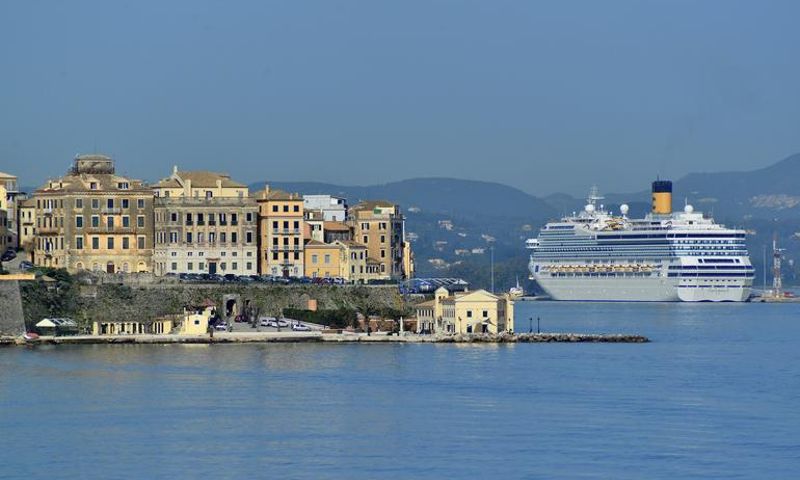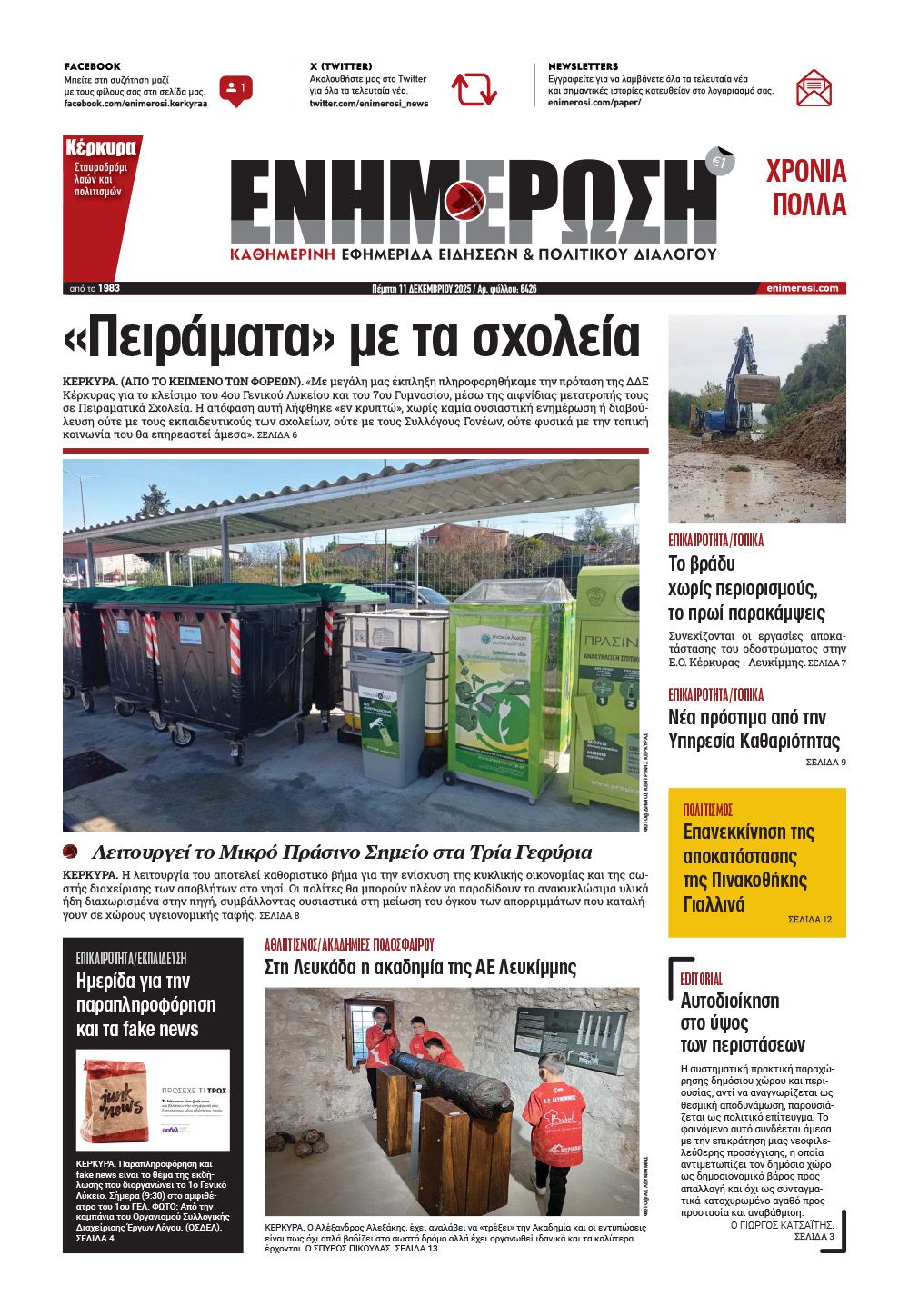Study: One cruise ship emits as much air pollution as 50,000 cars!

cruies ships
02 Jul 2019
/ 06:06
If uncontrolled, the continuing development of cruise ships worldwide is expected to have a greater impact on the Greek seas and the limited island infrastructure.
Greece and destinations such as Santorini, Mykonos and others are at the top of the list of European locations significantly affected by the emissions from cruise ships. According to a study by the European organisation Transport & Environment, which campaigns for the reduction of transportation pollution, the emission of sulphur oxide (SOX) from cruise ships in Greece especially is 120 times greater than that from all the small vehicles in the country! Spain, Italy and Greece are the three European countries most exposed to SOX air pollution from cruise vessels.
The SOX emissions from the 115 cruise ships that came to Greek ports in 2017 was 7,600 tons compared to 64 tons from cars and other small vehicles - one of the worst records in Europe behind Croatia, Norway and Iceland.
In 2017 one of the world’s largest luxury cruise operators,emitted nearly 10 times more sulphur oxide (SOX) around European coasts than did all 260 million European cars! SOX emissions increase human health risks and contribute to acidification in terrestrial and aquatic environments.
Nitrogen oxide (NOX) emissions from cruise ships in Europe also heavily impact the ecosystem. According to the study, cruise ships emit the equivalent of about 15% of the nitrogen oxides (NOX) emitted by Europe’s passenger car fleet in a year.
In Marseille, for example, 57 cruise ships emitted in 2017 almost as much NOX as 25% of the city’s 340,000 passenger cars. In Greece the figures are even worse - the SOX emissions from the 115 cruise ships in 2017 were the equivalent of 64% of those from all passenger cars over the year. The situation is as bad in ports in other countries such as Norway, Denmark, Croatia and Malta.
The study recommends stricter regulations regarding emissions from cruise ships with desulphurisation and other systems, pointing out that these ships are usually close to the coast and remain in tourist ports for a long time thus impacting the atmosphere there. It also recommends that cruise ships, which are a form of luxury tourism, should be the first to be regulated as regards vessel emissions.
Transport & Environment researchers foresee that even after the implementation of the new regulations regarding the sulphur content of shipping fuel in January 2020 cruise ships will still be a greater source of SOX emissions than passenger cars. In Greece the amount of cruise ship SOX emissions will be 40 times greater than those from passenger cars despite the new, stricter regulations. This will place us top of the list in Europe ahead of Spain and Italy. Barcelona, Palma de Mallorca and Venice will remain the most impacted European port cities.
One cruise ship emits as much air pollution as 50,000 cars
The Transport & Environment study states that even a relatively small number of cruise ships emits a very large amount of air pollution into the atmosphere. International studies show that for every hour that the engines are running a 50,000 ton cruise ship emits particulates equivalent to those of 50,000 cars travelling at 130kph. It also emits nitrogen oxide equivalent to that from 45,000 cars and carbon dioxide equivalent to that from 7,000 cars.
See the top cruise ship-polluted ports here

Transport & Environment
The high emissions sulphur oxide, nitrogen oxide and other gases is attributed both to the composition and quality of marine fuels used by cruise ships and to the present engine emission prototypes. Analysts add that the situation is worsening due to the large engines used by these 'floating cities' and the long time spent in ports and close to the coastline.
The compilers of the study state that even in ports or regions which have strict regulations to protect the environment cruise ships have a large negative impact on the environment. In recent years certain European regions have implemented strict regulations regarding emissions of gases, such as the Baltics, the Norwegian fjords, Malta and elsewhere - emission control areas (ECAs). In these areas ships that are moored for longer than two hours must use fuel that contains only 0.1% sulphur.
As cruise ships will continue to impact many European countries after 2020, when new regulations regarding marine fuel will come into force, the study recommends additional measures. One of these is for cruise ships when in port to connect to shore-side electricity. Even though this option exists in European guidelines there have been delays in its implementation, not only because shipowners and port authorities haven't invested. A significant problem is the fact that marine fuel is untaxed whereas electricity is taxed. For this reason, Transport & Environment recommends that electricity used by cruise ships in port be exempted from tax.
It also recommends stricter regulations regarding emissions from cruise ships in port so that owners are obliged to invest in technology which will allow them to connect to shore-side electricity networks.
The report also recommends extending emission control areas (ECAs) to all European seas with additional stricter regulations. Finally, it considers that these control areas need to include not only ports but also specific zones in the open sea, especially in tourist regions.
Transport & Environment was set up in 1990 and represents approximately 60 organisations from 25 European countries. Its main mission is to minimise the environmental impact of transport. As it says on its site "Our members and supporters represent approximately 3.5m people".
Emission Control Areas
The compilers of the study consider it necessary for European countries to take measures, giving the example of the emission control areas (ECAs) which have been in force in the Baltic, the Norwegian fjords and the English Channel for the last two years.
Passengers
The German NGO NABU maintains in a study that cruise passengers could be inhaling up to 60 times more harmful elements. It found concentrations in the region of 340,000 microparticles per cubic centimetre compared to 20 - 30,000 in a busy road.
The SOX emissions from the 115 cruise ships that came to Greek ports in 2017 was 7,600 tons compared to 64 tons from cars and other small vehicles - one of the worst records in Europe behind Croatia, Norway and Iceland.
In 2017 one of the world’s largest luxury cruise operators,emitted nearly 10 times more sulphur oxide (SOX) around European coasts than did all 260 million European cars! SOX emissions increase human health risks and contribute to acidification in terrestrial and aquatic environments.
Nitrogen oxide (NOX) emissions from cruise ships in Europe also heavily impact the ecosystem. According to the study, cruise ships emit the equivalent of about 15% of the nitrogen oxides (NOX) emitted by Europe’s passenger car fleet in a year.
In Marseille, for example, 57 cruise ships emitted in 2017 almost as much NOX as 25% of the city’s 340,000 passenger cars. In Greece the figures are even worse - the SOX emissions from the 115 cruise ships in 2017 were the equivalent of 64% of those from all passenger cars over the year. The situation is as bad in ports in other countries such as Norway, Denmark, Croatia and Malta.
The study recommends stricter regulations regarding emissions from cruise ships with desulphurisation and other systems, pointing out that these ships are usually close to the coast and remain in tourist ports for a long time thus impacting the atmosphere there. It also recommends that cruise ships, which are a form of luxury tourism, should be the first to be regulated as regards vessel emissions.
Transport & Environment researchers foresee that even after the implementation of the new regulations regarding the sulphur content of shipping fuel in January 2020 cruise ships will still be a greater source of SOX emissions than passenger cars. In Greece the amount of cruise ship SOX emissions will be 40 times greater than those from passenger cars despite the new, stricter regulations. This will place us top of the list in Europe ahead of Spain and Italy. Barcelona, Palma de Mallorca and Venice will remain the most impacted European port cities.
One cruise ship emits as much air pollution as 50,000 cars
The Transport & Environment study states that even a relatively small number of cruise ships emits a very large amount of air pollution into the atmosphere. International studies show that for every hour that the engines are running a 50,000 ton cruise ship emits particulates equivalent to those of 50,000 cars travelling at 130kph. It also emits nitrogen oxide equivalent to that from 45,000 cars and carbon dioxide equivalent to that from 7,000 cars.
See the top cruise ship-polluted ports here

Transport & Environment
The high emissions sulphur oxide, nitrogen oxide and other gases is attributed both to the composition and quality of marine fuels used by cruise ships and to the present engine emission prototypes. Analysts add that the situation is worsening due to the large engines used by these 'floating cities' and the long time spent in ports and close to the coastline.
The compilers of the study state that even in ports or regions which have strict regulations to protect the environment cruise ships have a large negative impact on the environment. In recent years certain European regions have implemented strict regulations regarding emissions of gases, such as the Baltics, the Norwegian fjords, Malta and elsewhere - emission control areas (ECAs). In these areas ships that are moored for longer than two hours must use fuel that contains only 0.1% sulphur.
As cruise ships will continue to impact many European countries after 2020, when new regulations regarding marine fuel will come into force, the study recommends additional measures. One of these is for cruise ships when in port to connect to shore-side electricity. Even though this option exists in European guidelines there have been delays in its implementation, not only because shipowners and port authorities haven't invested. A significant problem is the fact that marine fuel is untaxed whereas electricity is taxed. For this reason, Transport & Environment recommends that electricity used by cruise ships in port be exempted from tax.
It also recommends stricter regulations regarding emissions from cruise ships in port so that owners are obliged to invest in technology which will allow them to connect to shore-side electricity networks.
The report also recommends extending emission control areas (ECAs) to all European seas with additional stricter regulations. Finally, it considers that these control areas need to include not only ports but also specific zones in the open sea, especially in tourist regions.
Transport & Environment was set up in 1990 and represents approximately 60 organisations from 25 European countries. Its main mission is to minimise the environmental impact of transport. As it says on its site "Our members and supporters represent approximately 3.5m people".
Emission Control Areas
The compilers of the study consider it necessary for European countries to take measures, giving the example of the emission control areas (ECAs) which have been in force in the Baltic, the Norwegian fjords and the English Channel for the last two years.
Passengers
The German NGO NABU maintains in a study that cruise passengers could be inhaling up to 60 times more harmful elements. It found concentrations in the region of 340,000 microparticles per cubic centimetre compared to 20 - 30,000 in a busy road.
Transport & Environment / Kathimerini,gr












